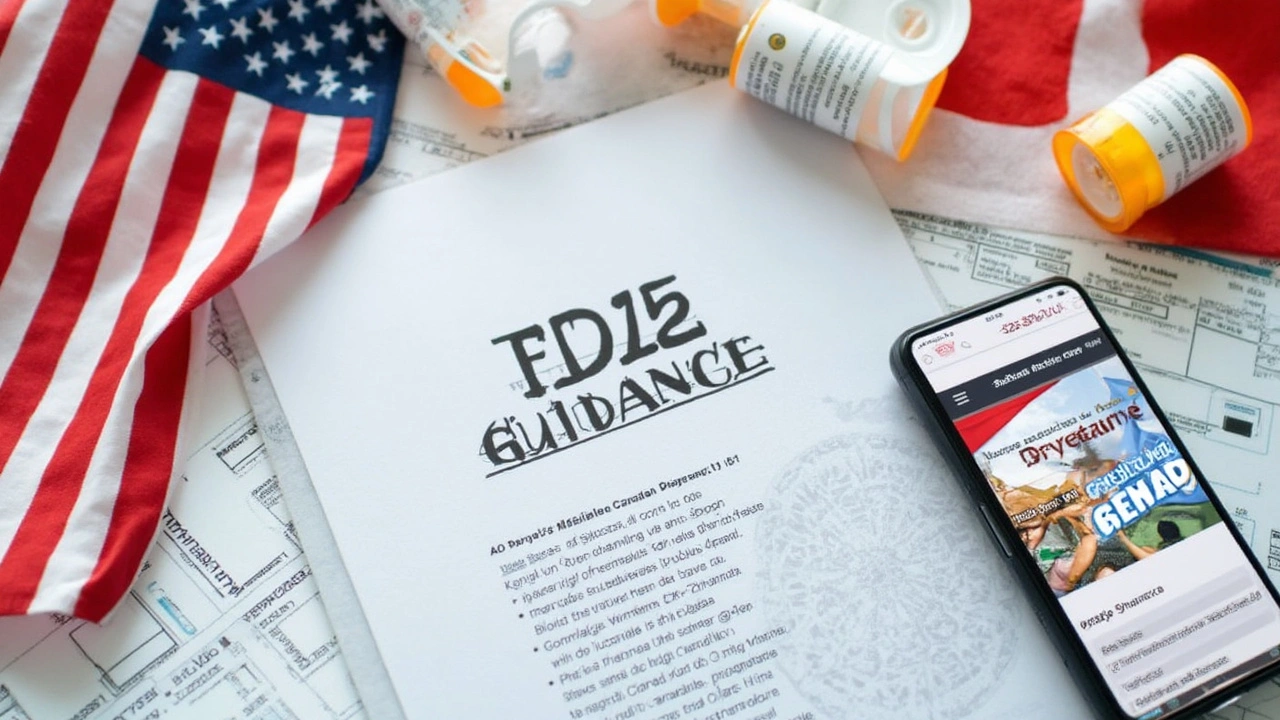The FDA’s 2025 Guidance: What’s Changed for Canadians Sending Medicine South?
Big shocker: Americans paid more than double for many prescription drugs compared to Canadians in 2024. With prices at home soaring, it’s not surprising to see a steady stream of U.S. patients relying on Canadian pharmacies. For years, this has been a legal gray area—sometimes tolerated, sometimes not—depending on who you ask at the border or what agency writes the rules. But in April 2025, the FDA issued new guidance aiming for clarity. Anyone hoping to bring in meds from Canada needs to pay attention to these changes if they want to avoid nasty surprises at customs or with their health later on.
The latest FDA rules still say importing medicine personally is technically illegal—with some exceptions. The agency now lists explicit circumstances where a patient might legally order medicine from Canada: if the drug is for personal use, the treatment is for a serious condition, and there’s no available equivalent in the U.S. You’ll also need a valid U.S. prescription, and the supply can’t go over 90 days. Seems simple? It isn’t. There’s no guarantee you won’t be stopped at the border, and customs officers still have the power to seize shipments. Plus, buying from unverified sources carries its own risks. What’s new and encouraging, though, is a clearer process for showing medical necessity, plus improved guidelines for state-run import programs (like those running in Florida and Colorado).
The FDA now explicitly encourages U.S. doctors to provide supporting documentation when their patients are seeking medications that aren’t available or affordable locally. That means if your oncologist writes a detailed note about your need for cancer medication at Canadian prices—and you stick to the 90-day personal supply rule—your odds of successful delivery go up. But this isn’t a free pass: counterfeit concerns remain, and there’s a long list of restricted drugs (like controlled substances and biologics) you still can’t order in from Canada at all.
Transparency comes with a price. Many popular online pharmacies must now show licensing information and provide real-time price comparisons with U.S. equivalents. The FDA is also working with Canadian regulators to flag unapproved or shady pharmacies posing as Canadian (but really ships from countries simply posing as Canada). This extra layer aims to weed out scams, but it also means Americans need to be more diligent: look for pharmacy verification seals, consult state health databases, and check with your insurance provider before placing an order.
Inside the Import Process: Steps and Stumbles at the Border
The fantasy goes like this: fill out a form on a Canadian pharmacy’s website, upload your U.S. prescription, pay half what you’d spend locally, and enjoy a steady stream of affordable pills dropping into your mailbox every month. Reality has more snags, especially now that the FDA’s new rules clarify what gets flagged for seizure and what slides through. Your prescription is only step one. You’ll need to prove you’re not exceeding the 90-day limit, and border agents may ask for copies of your diagnosis and prescription. Sometimes they even call prescribing doctors for verification—delaying shipments for weeks.
If your meds get stopped, the FDA will usually send a seizure notice with instructions to appeal. Don’t panic, but don’t expect sympathy—ordinary painkillers get more scrutiny than insulin, for example. Surprise, surprise: some states (like Florida) are testing bulk importation programs that add a layer of legal protection for certain medicines. If you’re lucky enough to live in those states, you might get access to Canadian prices without the stress. Most Americans, though, still face out-of-pocket costs if their packages vanish at customs.
Fumbling through tricky regulations isn’t the only stumbling block. While thousands of Americans successfully import from Canada every month, they do so at their own risk. Cross-border delivery can take up to four weeks (especially if customs inspects the package). Some U.S. credit cards and PayPal accounts may flag foreign transactions as suspicious, so stay prepared for banking hiccups. Other times, so-called Canadian pharmacies ship medication from India or Southeast Asia—sometimes legitimate, but more often a sign of a less-than-reliable operation.
Pitfalls aside, those who do their homework get results. Tip: Save every document—prescription, diagnosis, shipment tracking, customs emails, and even your doctor’s support letter—in a single file. This keeps headaches at bay when something inevitably goes wrong (and increases the chance of a successful appeal if the FDA or customs gets cold feet about your order).

Getting the Best Deal on Safe Canadian Medicine: Smart Patient Tips
The new FDA rules put even more pressure on buyers to steer clear of sketchy websites. Here’s how smart patients vet their options and track down the best safe Canada pharmacy deals without rolling the dice on their money or health. First, stick to pharmacies that ask for a valid U.S. prescription—if they don’t, that’s a red flag. Next, look for the CIPA (Canadian International Pharmacy Association) seal, approved by Canadian authorities to weed out fakes. Most reputable sites also show a “Verified Internet Pharmacy Practice Sites” (VIPPS) logo, which means they meet tough safety requirements.
Want to make comparisons without hopping from one site to another? Resources that aggregate prices and safety data can be lifesavers. For a curated list of reliable stores besides the big names, check guides like safe Canada pharmacy deals. You’ll get up-to-date info on which sites are currently verified and those that offer shipping to your state. Pro tip: Check whether the pharmacy displays its address and real pharmacist contact information. If you see only an email form and no physical address, that’s riskier.
Here’s an inside secret some Americans use: ask your doctor to provide your prescription in both English and French. Some border agents move shipments faster if the label matches both Canadian and U.S. packaging languages. It’s a quirky trick, but frequent importers swear by it. While comparison shopping, also note shipping costs—some pharmacies lure with low drug prices but hit you hard at checkout.
One more tip: keep track of reviews on third-party forums (like Reddit or Trustpilot) where real customers share their experiences with customs and border agents. If several users complain about a particular website’s packages getting confiscated, steer clear. Regulators can update import rules year to year, so patient forums often react much faster to changing requirements than government websites.
The Gray Line: Legal Loopholes and State-Sponsored Import Programs
For the last decade, U.S. officials have danced around the idea of large-scale Canadian imports as a fix for skyrocketing drug costs. Things heated up in late 2024, when Colorado received FDA green light to launch its “bulk importation” scheme. Florida’s been running similar programs for a while, and several other states are asking for permission to import big batches of commonly used meds for distribution to residents. The fine print is wild: only certain drugs qualify, and Canadian companies must agree to U.S. testing and repackaging rules. Patients who get their meds through these programs skip the usual 90-day rule, and the process is much more transparent. But the catch? The list of included drugs is short, and waiting lists for state programs are long enough to frustrate anyone living with a chronic condition.
Outside those state-run efforts, there’s no loophole that gives personal importation a get-out-of-jail-free card. Some Americans try routing packages through British Columbia border towns or mailing parcels to friends in Canada (who then reship to the U.S.), but the FDA can trace most shipments. And while Congress occasionally talks up bipartisan solutions to let Americans buy directly from Canadian pharmacies, federal law changes slowly. Anyone promising a miracle import workaround is probably selling snake oil.
Technically, travelers may bring a small supply (usually a 90-day personal dose) when crossing by land—if they declare it and have matching prescription paperwork. But with border agents more alert than ever, even that’s not a risk-free move. Stories circulate about agents ignoring boxes of insulin for one patient and seizing cholesterol meds from another who didn’t have the right letter from their doctor. Plan for delays, and keep copies of every document in your travel bag if you’re making a pharmacy run up north.
| Medicine Type | Allowed for Import? | Notes |
|---|---|---|
| Generic Blood Pressure Pills | Yes | If for personal use, doctor's note required |
| Insulin | Sometimes | Rules change by state; always carry a prescription |
| ADHD Medication | No | Classified as a controlled substance |
| Biologics (e.g., Humira) | No | FDA restricts importation of biologics |
| Cholesterol Drugs (Statins) | Yes | Personal supply limit applies |

What Patients Should Watch for Next: Where Import Rules Might Head in 2026
If you’re wondering whether bringing in cheaper drugs from Canada will get easier, don’t hold your breath. The 2025 FDA guidance is a balancing act between protecting patients from unsafe meds and preventing price gouging by U.S. insiders. So far, there’s little sign that Washington plans big legal changes—especially not in an election year. That means American patients hoping for a quick fix will likely still face hurdles, paperwork, and awkward questions at customs.
One interesting trend: more U.S. health insurers are adding “cross-border” coverage to specific plans, hoping to cut costs for everyone by letting members shop Canadian for select generic drugs. These programs have strict eligibility criteria—usually focused on diabetes and heart medications. If your insurance plan hints at new cross-border perks in 2025, don’t ignore the small print. Call customer service and ask pointed questions about which drugs are covered, how claims work, and whether the insurer provides a shortlist of trusted Canadian pharmacies. You might save hundreds, but only if you follow each rule perfectly.
Keep tabs on the FDA’s official website and Canadian authorities (like Health Canada) for new scam warnings and any tweaks to the importation guidelines. Pharmacy associations regularly update lists of certified suppliers—worth checking frequently, as the black market adapts faster than regulators can keep up.
At the end of the day, the biggest winners are savvy patients who combine caution with research. Don’t get lured in by too-good-to-be-true offers on life-saving meds, and don’t underestimate the power of a correctly filled prescription, a supportive doctor, and a little paperwork. If you’re careful, mindful, and willing to dig for the best safe Canada pharmacy deals, importing medicine from Canada can still be a lifeline in 2025, just not the easy street some might hope for.


Calvin Smith
July 18, 2025 AT 17:06Oh great, just what we needed: another FDA policy to untangle. Honestly, the whole idea that Americans have to run to Canada for affordable meds screams about how messed up our healthcare system is. It’s like patchwork solutions for a damn sinking ship.
The article sounds like it's trying to be a beacon of hope, but let’s be real—border bureaucracy and prescription rules often turn these 'safe' imports into a nightmare maze. I’m curious, though, how different is this 2025 guidance from what was already in place? And how much is it going to actually help people and not just fatten some bureaucrat’s pocket?
Either way, if you’re gonna play this FDA game, knowing the real nitty-gritty is key. I hope the article doesn’t sugarcoat the risks because those can be life or death when it comes to meds.
Brenda Hampton
July 22, 2025 AT 02:07Wow, this is actually super helpful! I’ve always wondered about the legal side of importing meds from Canada because the price difference is crazy. It makes me anxious thinking about what happens if you get caught or if your meds are confiscated.
Does the article mention if you need a Canadian prescription or if a U.S. doctor’s prescription works? Also, how strict are the border agents? I feel like there’s always this fuzziness around what counts as legal importation versus what doesn’t.
I can totally see this easing financial stress for many, but I’d love tips on how to keep everything above board and avoid nasty surprises.
Lara A.
July 25, 2025 AT 10:34Seriously, do we even trust these FDA 'updates'? The government’s just another cog in Big Pharma’s brutal machine, trying to maintain their stranglehold on drug prices. I bet there are all kinds of fine print rules and loopholes that serve only to keep the upper hand with them.
And let’s not even start on how this will affect patient privacy or how the border officials will misuse this “guidance” to harass travelers. This isn’t about helping people, it’s about control, plain and simple.
Anyone else suspicious the 'safe' part is just a convenient cover to keep people scared and dependent on overpriced meds?
Marcella Kennedy
July 28, 2025 AT 22:21Reading about these FDA rules gives me mixed feelings. On one hand, I feel relieved that there might be safer, more affordable options for people struggling to pay for medication.
However, the complications with prescription requirements and border regulations might intimidate many patients, especially those who are already vulnerable. It would be wonderful if the article includes some compassionate guidance on how patients can navigate the system without stress.
We need more voices emphasizing empathy and support to create understanding, not confusion. Are there recommended resources for community support or advocacy groups that can help?
Let’s keep the conversation going because this is about lives and dignity.
Jamie Hogan
August 1, 2025 AT 09:27The title promises much, but the reality always falls short. As a fellow European, observing this from abroad, I am intrigued by the intricacies of transnational pharmaceutical trade laws. The legal balancing act between ensuring safety, affordability, and sovereignty is enormously complex.
Does this article touch on possible repercussions for the Canadian supply chain? Because the last thing needed is Americans draining Canadian resources, leading to localized shortages.
Moreover, I hope the discourse acknowledges how this FDA initiative could impact the bilateral relationship or the intricate healthcare policies uniquely tied to North America.
Ashishkumar Jain
August 4, 2025 AT 20:36I think this new guidance can make a lot of positive difference if it is executed with clear, accessible info for everyone. Often policies sound good on paper but fail when ordinary people try to use them because they get overwhelmed.
The balance between safety and affordability is delicate, but not impossible. Importantly, educating people about risks and smart practices is vital; this article seems to cover that well.
Maybe this is a step toward a more compassionate, practical healthcare environment. Let's hope this sparks better collaborative efforts between countries to serve all citizens' health needs.
Anyone else here hoping this leads to broader reform?
😊Gayatri Potdar
August 8, 2025 AT 07:49Ughhh, I don't trust any of this crap! The government playing nice with Canada about medicine? More like a sneaky ploy to track what meds people are taking so they can control the population better!!!
They probably will make the prescription rules so ridiculously complicated you’ll need a lawyer just to figure out what's allowed.
And the risks? Every little thing is risky when you deal with these agencies. They don't want us to be healthy, they want us hooked and broke!
People better be careful, this smells like a big fishy mess!!!
Poonam Mali
August 11, 2025 AT 18:59Just what the neoliberal apparatus needed—a shiny new FDA import framework dressed up as patient salvation but underpinned with layers of regulatory capture and pharmaceutical hegemony. The jargon around “safe imports” glosses over systemic inequities and the commodification of health itself.
The border protocols and prescription stipulations are performative gestures at control masked as consumer empowerment. It’s essential to interrogate these frameworks through critical lenses to unpack who truly benefits and at what cost.
Does the article engage with power structures behind these policies, or does it piously handhold the readers through the bureaucratic maze? Questions worth pondering deeply.
Alan Whittaker
August 15, 2025 AT 02:59As expected, the FDA's new rules are nothing but a thin veil to placate the masses while maintaining the Status Quo of monopolistic Big Pharma tyranny. The safeguards they claim are there? Just elaborate smoke and mirrors.
Knowing the convoluted prescription requirements will do nothing when the true power lies in their ability to arbitrarily enforce or deny access based on corporate interests masked as border security concerns.
It's laughable to believe this 'guidance' is truly about helping anyone but shareholders. Why not focus on systemic drug price reform domestically rather than pushing desperate Americans to navigate foreign bureaucracies?
Ram Dwivedi
August 16, 2025 AT 09:59Hey everyone, I appreciate all these perspectives! While concerns about pharma control and government bureaucracy are valid, I think cautiously optimistic views are needed here. Policy changes often come with rough edges but may initiate positive shifts.
For those wondering about prescription specifics: usually, a valid U.S. prescription is required, but nuances exist on how it’s verified at border customs.
Smart use of approved resources and transparent communication can empower patients to navigate new rules without undue stress. Nothing is perfect, but progress happens in small steps.
Stay safe and informed!
😊Marcella Kennedy
August 17, 2025 AT 17:06Thank you for chiming in with those clarifications! I completely agree that while skepticism is healthy, it’s equally important to foster hope and practical knowledge.
Maybe this article can serve as a bridge to unite diverse voices—those calling for caution, and those advocating for change—with concrete guidelines to help vulnerable people.
I also wonder if it addresses insurance complexities because many patients face layers of hurdles beyond just drug costs.
Has anyone encountered or heard of community programs helping Americans safely import meds under the new rules?